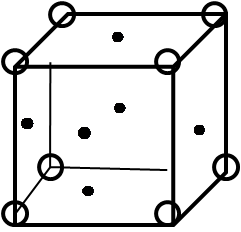
How do you find the coordination number of sodium chloride (NaCl)?
Answer
434.1k+ views
Hint: The crystal lattice of any molecule is the three – dimensional arrangement of its atoms. In a crystal, the arrangement of atoms is in a way that some atoms surround others. The number of atoms surrounding each atom is a coordination number of that atom. The lattice type of NaCl is Face centered cubic cell.
Complete answer:
The coordination number of any atom is defined as the number of atoms surrounding that atom in its crystal lattice structure. A unit cell is the smallest part of a crystal. A crystal lattice consists of various lattice points, these points are the ions or atoms of the molecule. Unit cells are of primitive (simple) and centered unit types that have FCC, BCC, and ECC.
We have NaCl which is an ionic solid. It is formed in the stoichiometric ratio of 1 : 1 as, 1 sodium atom

This implies that one
Hence, the coordination number of sodium chloride NaCl is 6.
Note:
The 1 : 1 stoichiometry makes it possess the same coordination number for both atoms. The other unit cells include, BCC that is body centered cell, which has particles at the corners and one at the center. While, ECC called end centered cell has particles on corners and at the two opposite faces.
Complete answer:
The coordination number of any atom is defined as the number of atoms surrounding that atom in its crystal lattice structure. A unit cell is the smallest part of a crystal. A crystal lattice consists of various lattice points, these points are the ions or atoms of the molecule. Unit cells are of primitive (simple) and centered unit types that have FCC, BCC, and ECC.
We have NaCl which is an ionic solid. It is formed in the stoichiometric ratio of 1 : 1 as, 1 sodium atom

This implies that one
Hence, the coordination number of sodium chloride NaCl is 6.
Note:
The 1 : 1 stoichiometry makes it possess the same coordination number for both atoms. The other unit cells include, BCC that is body centered cell, which has particles at the corners and one at the center. While, ECC called end centered cell has particles on corners and at the two opposite faces.
Latest Vedantu courses for you
Grade 8 | CBSE | SCHOOL | English
Vedantu 8 CBSE Pro Course - (2025-26)
School Full course for CBSE students
₹45,300 per year
Recently Updated Pages
Master Class 11 Economics: Engaging Questions & Answers for Success

Master Class 11 Business Studies: Engaging Questions & Answers for Success

Master Class 11 Accountancy: Engaging Questions & Answers for Success

Master Class 11 English: Engaging Questions & Answers for Success

Master Class 11 Computer Science: Engaging Questions & Answers for Success

Master Class 11 Maths: Engaging Questions & Answers for Success

Trending doubts
State and prove Bernoullis theorem class 11 physics CBSE

1 ton equals to A 100 kg B 1000 kg C 10 kg D 10000 class 11 physics CBSE

State the laws of reflection of light

One Metric ton is equal to kg A 10000 B 1000 C 100 class 11 physics CBSE

1 Quintal is equal to a 110 kg b 10 kg c 100kg d 1000 class 11 physics CBSE

Difference Between Prokaryotic Cells and Eukaryotic Cells




